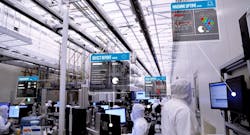When Intel acquired Saffron Technology in late 2015, it saw an opportunity for the company’s cognitive computing platform to improve the engineering time and overall quality of Intel chip design. Intel had been an early user of the technology—Saffron’s second customer, in fact—and could see how it improved the chipmaker’s ability to get product to market.
In those days, Saffron artificial intelligence (AI) was a platform that would be implemented with customers one by one. Now Intel has released a suite of software applications to make it easier for companies to take advantage of AI’s decision-making help in complex manufacturing, aerospace and software.
“We have been working to provide a new form of learning approaches using software to serve our enterprise customers around the world,” said Gayle Sheppard, vice president and general manager of Intel’s Saffron AI Group.
The Intel Saffron AI Quality and Maintenance Decision Support Suite works with any type of data—structured and unstructured—to provide insights, surface answers and reduce wasted efforts. It uses associative memory learning and reasoning AI to improve product quality and time to market.
“Intel Saffron AI uses associative memory learning and reasoning. It simulates a human’s natural ability to learn, remember and reason in real time,” said Sheppard, who served as chairman and CEO of Saffron Technology before Intel acquired the company. “We live in a very dynamic, heterogeneous world of data. We try to mimic that with technology. With technology we can access an infinitely larger data set than humans can.”
The technology surfaces tribal knowledge—insights about previous issues, how they were resolved, who resolved them, what information was needed—that is often hidden in the data and difficult to find via a normal word search. It learns from highly variable and even incomplete data, without relying on statistical models that need to be trained.
The Saffron technology combines supervised and unsupervised learning. It also provides transparent analysis of heterogeneous data. “This is really a huge issue today. This transparency is critical to all new modern AI systems,” Sheppard said, explaining the need for people to not only receive recommendations, but also understand what’s behind those recommendations. “The explainability and transparency, at the end of the day, is going to allow for confidence in the decision to aid in decision-making.”
The AI suite is made up of two software applications:
- Similarity Advisor finds the closest match to an issue—across resolved cases as well as those still under review—to identify paths to resolution and to surface duplicates to reduce backlogs.
- Classification Advisor automatically classifies work issues into pre-defined categories, whether regulator-mandated or self-defined. This speeds up and increases reporting accuracy while improving operations planning.
“We take the wisdom of experience of many and apply it to a new activity,” Sheppard said, explaining that the technology also supports one-shot learning. “A single instance of an experience can be useful just like it can be for humans.”
The system continuously learns from user feedback and new data inputs. “In addition to taking past experience, we’re taking new information about the defects in front of us,” Sheppard explained. “Intel Saffron sees something once and remembers and learns from it. As new information arrives, it’s refining its understanding of the data. Incremental learning is a big part of the system and why it’s useful to customers.
Accenture has already been using Intel Saffron AI for two years as a means to improve decision-making in testing. “Test engineers spend 90 percent of their time managing test cases and documenting rather than actually testing,” said Mallika Fernandes, AI innovation lead for testing at Accenture. In conjunction with Accenture’s Touchless Testing Platform, the Saffron AI technology supports rapid decision-making and helps reduce over-engineering efforts by 30-50 percent, she added.
The Saffron AI technology is well suited to tracking and resolving issues—anywhere where cycle times are fast and time to market is critical, Sheppard said. “Our experience so far has been in silicon manufacturing, aerospace and a wide variety of manufacturing,” she said, also noting customers in high-tech electronics outside of semiconductor manufacturing. “Oil and gas is another industry where this type of technology can help very quickly.”
In the case of Intel’s own work, its Client Computing Group had high-level engineers spending time on bugs. “Thirty percent of the bugs were identified as duplicates, so they were spending a lot of unnecessary time on duplicates,” Sheppard explained.
Using Saffron improved triage time by 35 percent and reduced engineering time by 25-35 percent. It also provided complete root cause analysis. “It’s improving the time but also the overall quality of the Intel chip design,” Sheppard said. “That’s a key reason that Intel acquired Saffron.”
Saffron’s first customer was an aircraft manufacturer dealing with some 15,000 legacy aircrafts still operating. A grounded aircraft cost the company $1 million a day, but a failed part anywhere from four hours to weeks to be fixed. “We were able to get that down to five minutes,” Sheppard said. “We’re reducing the time to know and make decisions by having a comprehensive knowledge of the previous situations. We can describe how to approach it in the future as well as predict where it would happen in the fleet.”
Now Intel is articulating the Saffron technology into products that are easily adopted across industry, Sheppard noted. The Intel Saffron AI Suite brings faster and more accurate data-driven insight in an easy-to-use interface.
The AI suite is part of Intel’s larger AI portfolio, including a range of hardware and software capabilities. “It’s a platform of multiple learning types. Our brains don’t work in just one way. Intel’s portfolio has begun to match that approach,” Sheppard said. “It is knowledge unification across many learning systems. That’s missing in most approaches today. We bring them together so that we have much more complete information. We get better decisions, they’re more accurate, and because of compute—it’s the power of compute—we can get them faster.”
Leaders relevant to this article:

